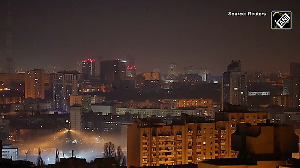Nepali Maoists have infiltrated into India with the locals spotting such cadres in Orissa's Malkangari district bordering Chhattisgarh where 53 securitymen and two civilians were killed in the last three weeks.
"We have received information about infiltration by Nepali Maoists, but nothing can be confirmed unless they are nabbed," a senior intelligence officer said, adding that Nepal sometime ago had indicated to India that a section of Maoists could cross over.
While 38 personnel, including 36 commandos of the elite Greyhound Force of Andhra Pradesh, were killed while sailing through the Balimela reservoir on June 29, 17 other Orissa police personnel died in a landmine blast triggered by suspected ultras on July 16.
"Though Malkangiri is identified as the hot-bed of Maoist activities, never before have such a large number of people been killed by ultras," Director General of Police Gopal Chandra Nanda said.
Worried over the increase in Maoist violence in Malkangiri district where 86 persons have been killed so far this year, Orissa Chief Minister Naveen Patnaik has asked the DGP to make a detailed report on the reason behind the incidents.
Though the Orissa police were yet to find the reason behind the sudden rise in the Maoist violence in the state, two to three rebels from Nepal were spotted by locals in Malkangiri.
Nanda told PTI that he had no knowledge about the presence of Nepali Maoists in Orissa.
Nepalese Maoist leader Prachanda's decision to embrace democracy had enraged many cadres in the Himalayan nation who could have infiltrated into Orissa and other states, the sources said.
With the Maoist movement aiming at establishing a red corridor from Pashupatinath in Nepal to Tirupati in Andhra Pradesh, the cadres could have jumped the boundary after Prachanda gained power in the Himalayan state, they felt.
Officers engaged in anti-Maoist operation were of the view that Maoists in India used to get moral as well as logistic support from their counterparts for long.
The existence of Nepali Maoists in Orissa was evident from the recovery of at least six CDs from Mandrabaju area of Gajapati district some time ago.
"The recovery of Nepali language CDs could be an indication to establish links between Maoists here and in Nepal," said Gajapti district SP S N Sinha.
This apart, a suspected Maoist identified as Sanjay Thappa was seen on the Orissa-Jharkhand border nearly two years ago.
South-Western Range Deputy Inspector General Sanjeev Panda who oversaw anti-Maoist operations in Malkangiri, Koraput and some other sensitive districts, suspected the hand of Maoists trained outside India behind both the incidents at Balimela and MV-126.
"One needs to be highly skilled to trigger landmines containing a huge quantity of explosives as was done in MV-126," Panda said.
The intensity of the explosion was so strong that an anti-landmine vehicle got damaged completely.
While Maoists operating in Orissa, Andhra Pradesh and Chhattishgarh were taking help of experts from other places, perhaps from Nepal, the Orissa government has changed its strategy to counter the menace.
"Besides launching an exclusive drive for appointing 5,000 officers and constables to work in Maoist-infested districts, we will recruit special police from local youths," Patnaik said.
It was also decided to engage 1,500 ex-defence personnel as special police in the anti-Maoist battle.
According to the decision, the special police would be given the Orissa police uniforms and trained to tackle the Maoists in forests and remote areas.
"We will take local youths who know the terrain and forests in their areas," the DGP said, adding that the government would relax physical standard for tribals because of their short height.
"The special police will assist the local police," said the DGP.
But with intelligence gathering considered as vital, Orissa has taken little steps in this direction.
"We need more people for information gathering than chasing Maoists in forests," said a senior officer.
Officers working in the field felt unless the government augmented the intelligence network by engaging more people, it would be difficult to tackle maoists who had informers in different strata of society.
"Maoists could kill 55 people in two ambush attacks as they have developed intelligence network even in forests and urban pockets," said a former DGP.






 © 2025
© 2025